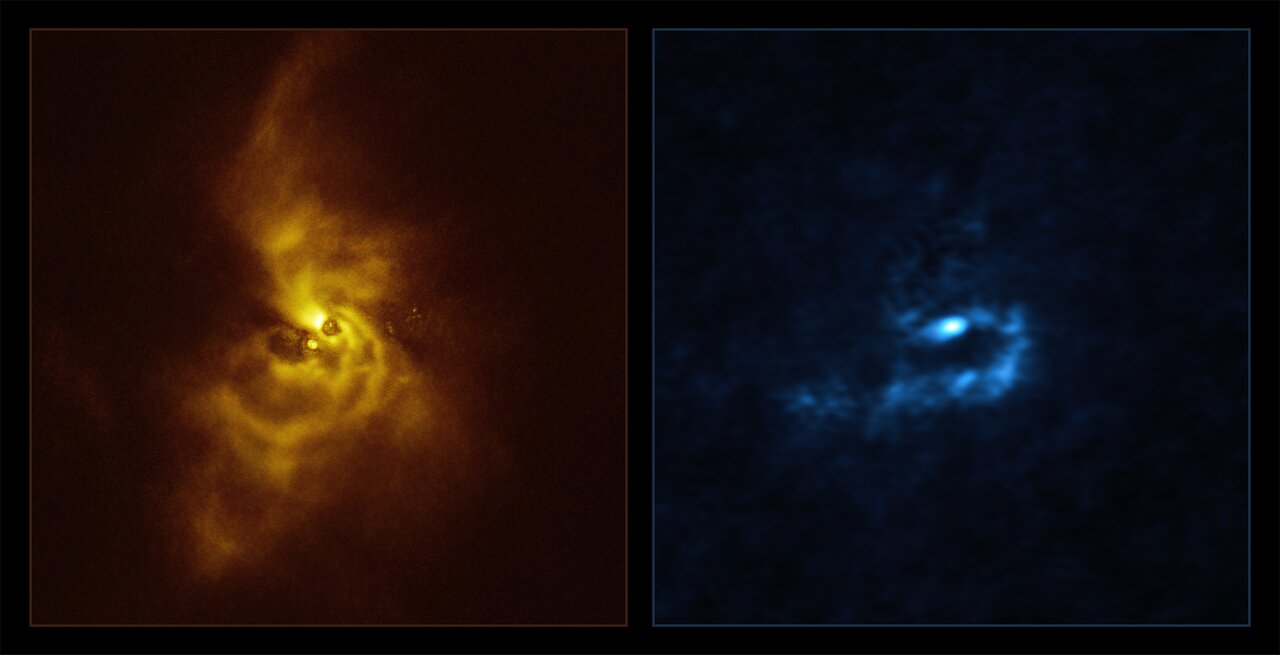Stunning image reveals 1st detection of gas giants being born around a young star (photo)
"This discovery is truly captivating as it marks the very first detection of clumps around a young star that have the potential to give rise to giant planets."

Astronomers have caught a glimpse of a stunning cosmic "phoenix" that represents a planetary system in the making.
Just like the mythological phoenix represents rebirth from fiery destruction, this cloud resembling a flaming cosmic bird may signify the birth of a gas giant planet from clumps of material gathered around a star that was recently born from the ashes of an earlier long-dead star. The study of dusty clumps around the star designated V960 Mon and located around 5,000 light-years away and the constellation of Monoceros could reveal how gas giant planets like Jupiter are born.
"This discovery is truly captivating as it marks the very first detection of clumps around a young star that have the potential to give rise to giant planets," Universidad Diego Portales, Chile, Alice Zurlo, part of the team behind the observations, said in a statement.
Related: 1st evidence found for 'Trojan planet' worlds occupying same orbit
The gold and blue image of the material around V960 Mon, which glows bright blue at the heart of the golden "wings" of gas and dust around it, was created with combined observations from the Very Large Telescope (VLT) and Atacama Large Millimeter/submillimeter Array (ALMA).
Witnessing the birth of a planetary system
Astronomers first turned their attention to the young star in 2014 when it unexpectedly brightened by about 20 times its usual magnitude. Observations with the VLT instrument Spectro-Polarimetric High-contrast Exoplanet REsearch (SPHERE) observations were taken shortly after this outburst of brightness, with the instrument able to catch an unprecedented level of detail in the system.
This showed material orbiting V960 Mon is forming a series of intricate spiral arms that stretch for distances greater than the entire solar system.
Get the Space.com Newsletter
Breaking space news, the latest updates on rocket launches, skywatching events and more!

This finding was followed up when astronomers observed V960 Mon with ALMA. While the VLT and SPHERE were able to look at the surface details of the clumps of dust and gas, ALMA could look deeper, revealing the inner structure of the system to astronomers and, in the process, the mechanism by which V960 Mon could be forming planets.
"With ALMA, it became apparent that the spiral arms are undergoing fragmentation, resulting in the formation of clumps with masses akin to those of planets," Zurlo said.

Astronomers suggest two avenues that gas giant planets could take to form. The first is core accretion, which sees dust grains gather to cover a rocky inner core. The second is gravitational instability, in which over-dense patches of a protoplanetary disk of gas and dust around a star collapse.
Scientists have seen hints at core accretion before, but the combined images from ALMA and SPHERE give astronomers a hint at the first observational evidence for this latter gas giant formation mechanism.
"No one had ever seen a real observation of gravitational instability happening at planetary scales — until now," researcher leader and University of Santiago, Chile, scientist Philipp Weber said.
The team intends to further study this planetary system in the making with the forthcoming Extremely Large Telescope (ELT) currently under construction in the Atacama Desert region of Northern Chile. The ELT should be able to reveal details of V960 Mon hidden even to the VLT and ALMA, including the chemical composition of the clumps of matter around the star.
"Our group has been searching for signs of how planets form for over ten years, and we couldn’t be more thrilled about this incredible discovery," team member and University of Santiago, Chile, researcher Sebastián Pérez said.
Join our Space Forums to keep talking space on the latest missions, night sky and more! And if you have a news tip, correction or comment, let us know at: community@space.com.

Robert Lea is a science journalist in the U.K. whose articles have been published in Physics World, New Scientist, Astronomy Magazine, All About Space, Newsweek and ZME Science. He also writes about science communication for Elsevier and the European Journal of Physics. Rob holds a bachelor of science degree in physics and astronomy from the U.K.’s Open University. Follow him on Twitter @sciencef1rst.
-
rod Some very cool images here. I do note that the first image, it looked like I could count 5-7 blue areas. Not sure how to interpret these blue clumps. Are they all separate gas giants forming? I note the space.com report stated, "With ALMA, it became apparent that the spiral arms are undergoing fragmentation, resulting in the formation of clumps with masses akin to those of planets," Zurlo said."Reply
Here is a simulation report on possible processes like this in discs. Do all gaps in protoplanetary discs host planets?, https://arxiv.org/abs/2307.11172
"...We locate the planets in the positions where the gaps in protoplanetary discs have been observed and we evolve the systems for 100Myr including a few Myr of gas disc evolution, while also testing three values of α viscosity. For planetary systems with initially three and four planets we find that most of the growing planets lie beyond the RV detection limit of 5AU and only a small fraction of them migrate into the inner region. We also find that these systems have too low final eccentricities to be in agreement with the observed giant planet population. Systems initially consisting of five or seven planets become unstable after ≈40Kyr of integration time. This clearly shows that not every gap can host a planet."
My note, the blue clumps seen in this article, perhaps very unstable conditions are developing too in the spiral arms.








